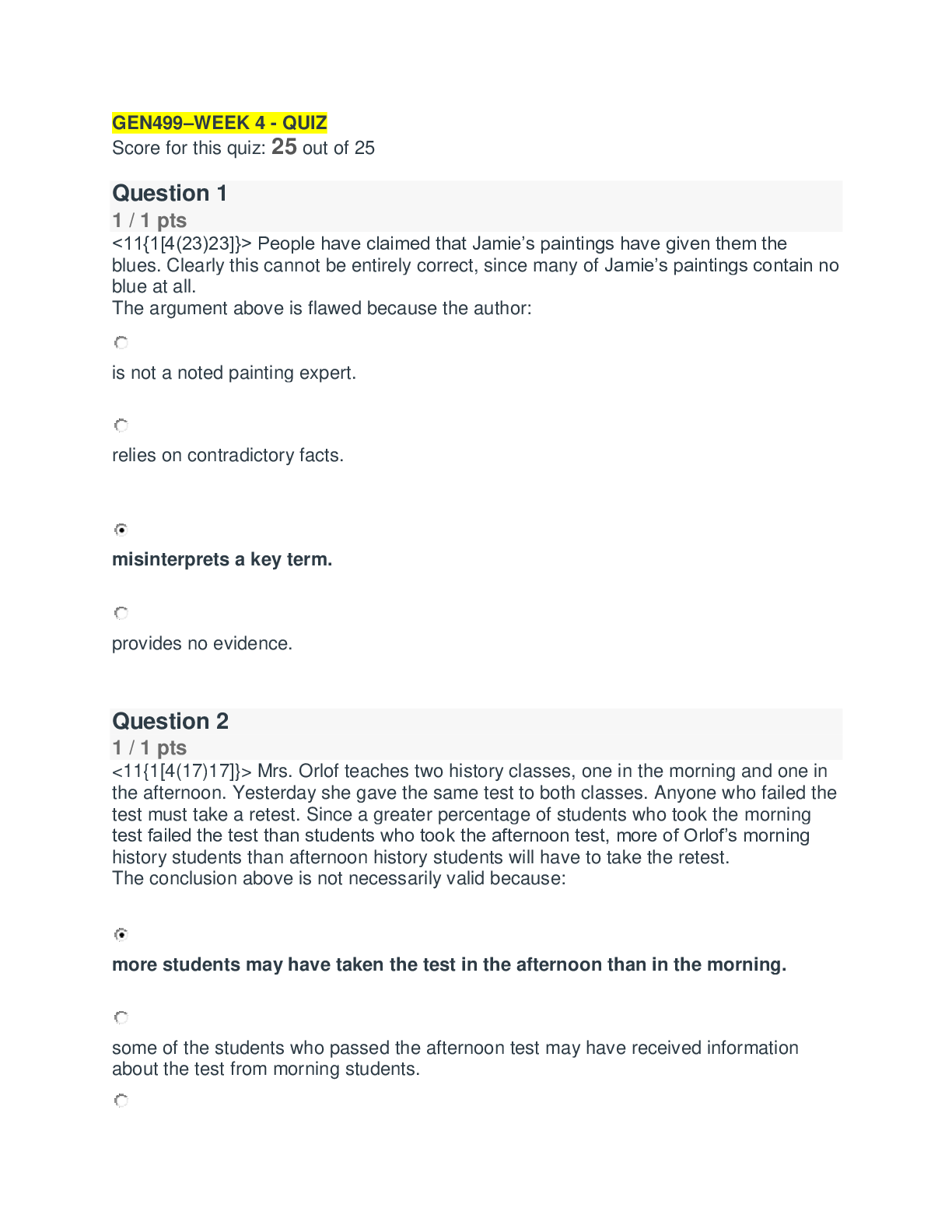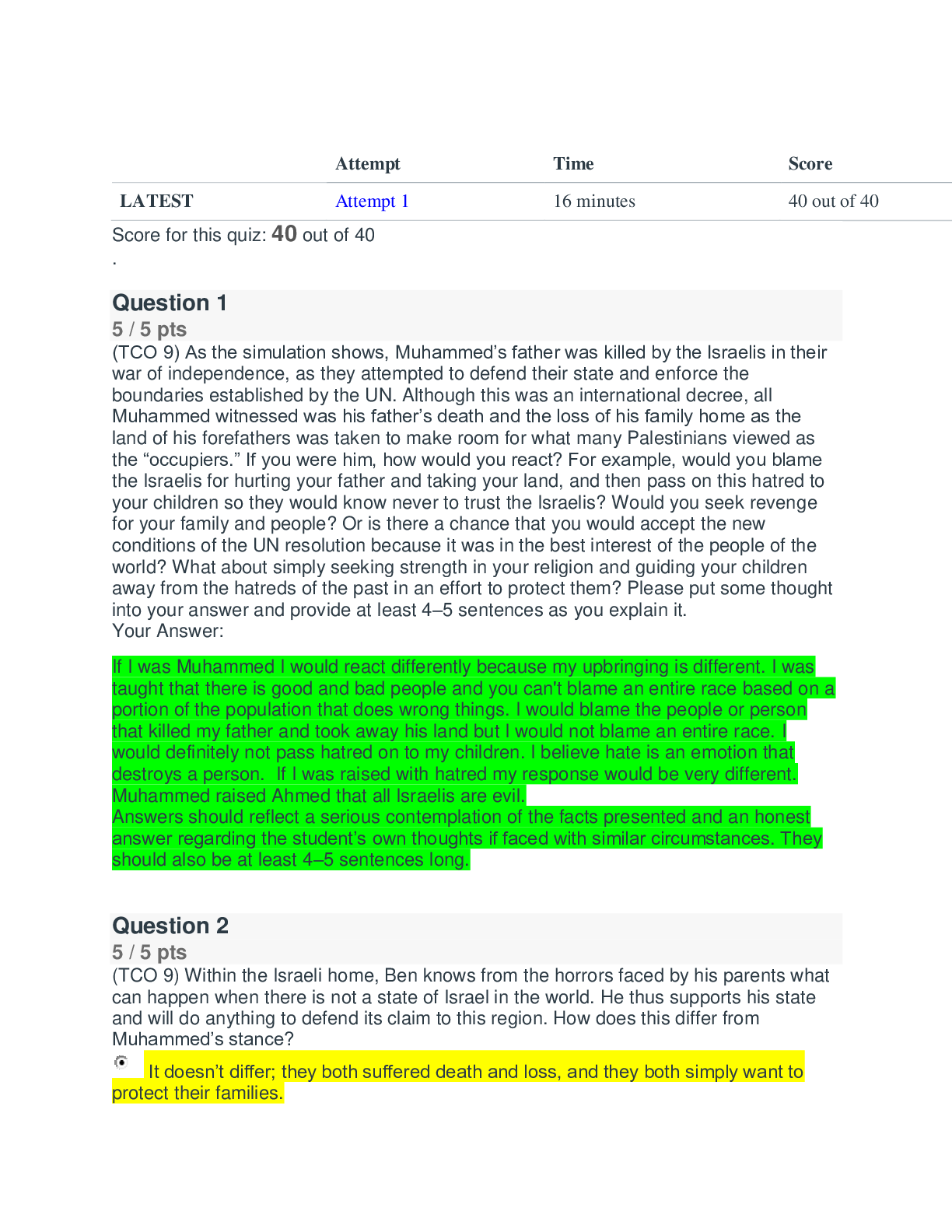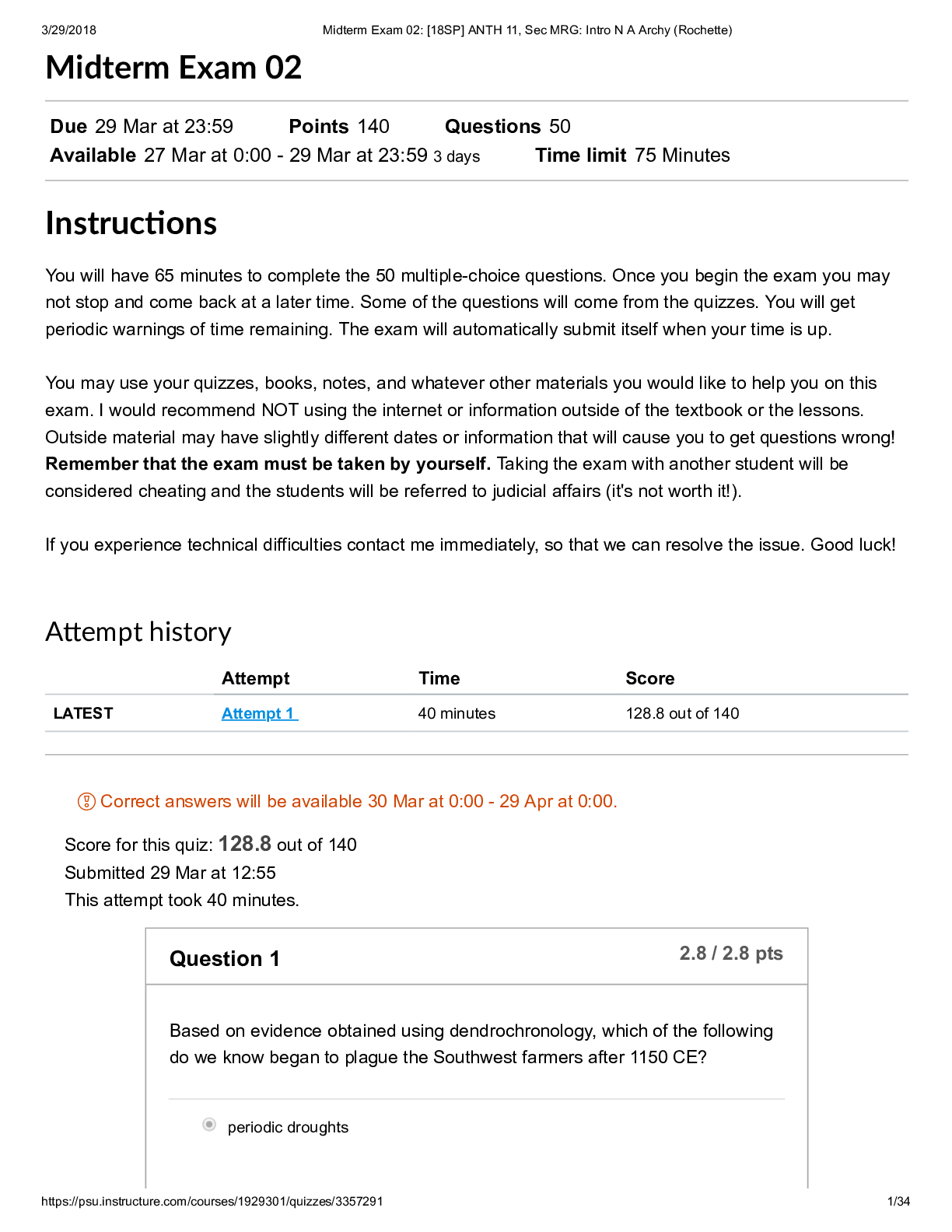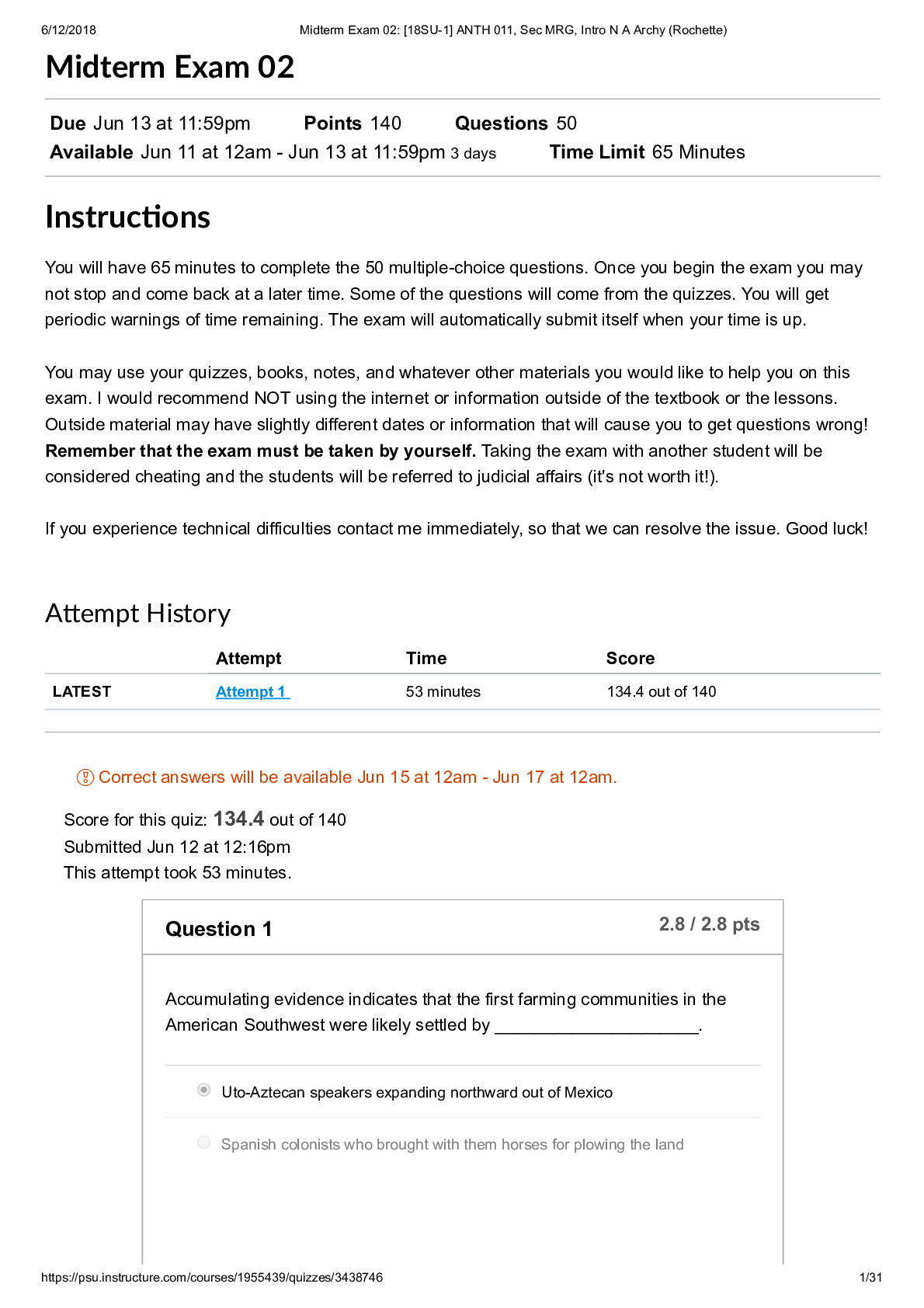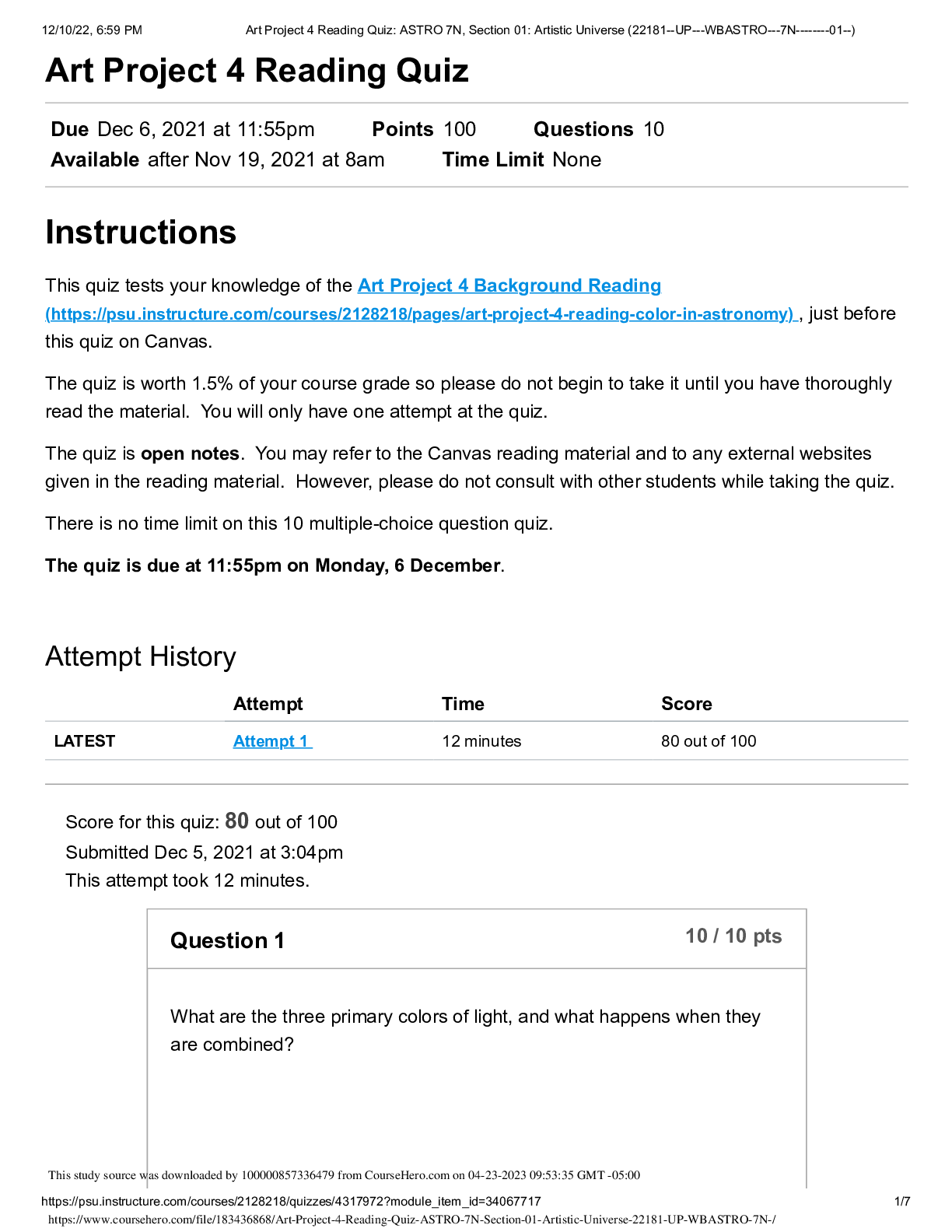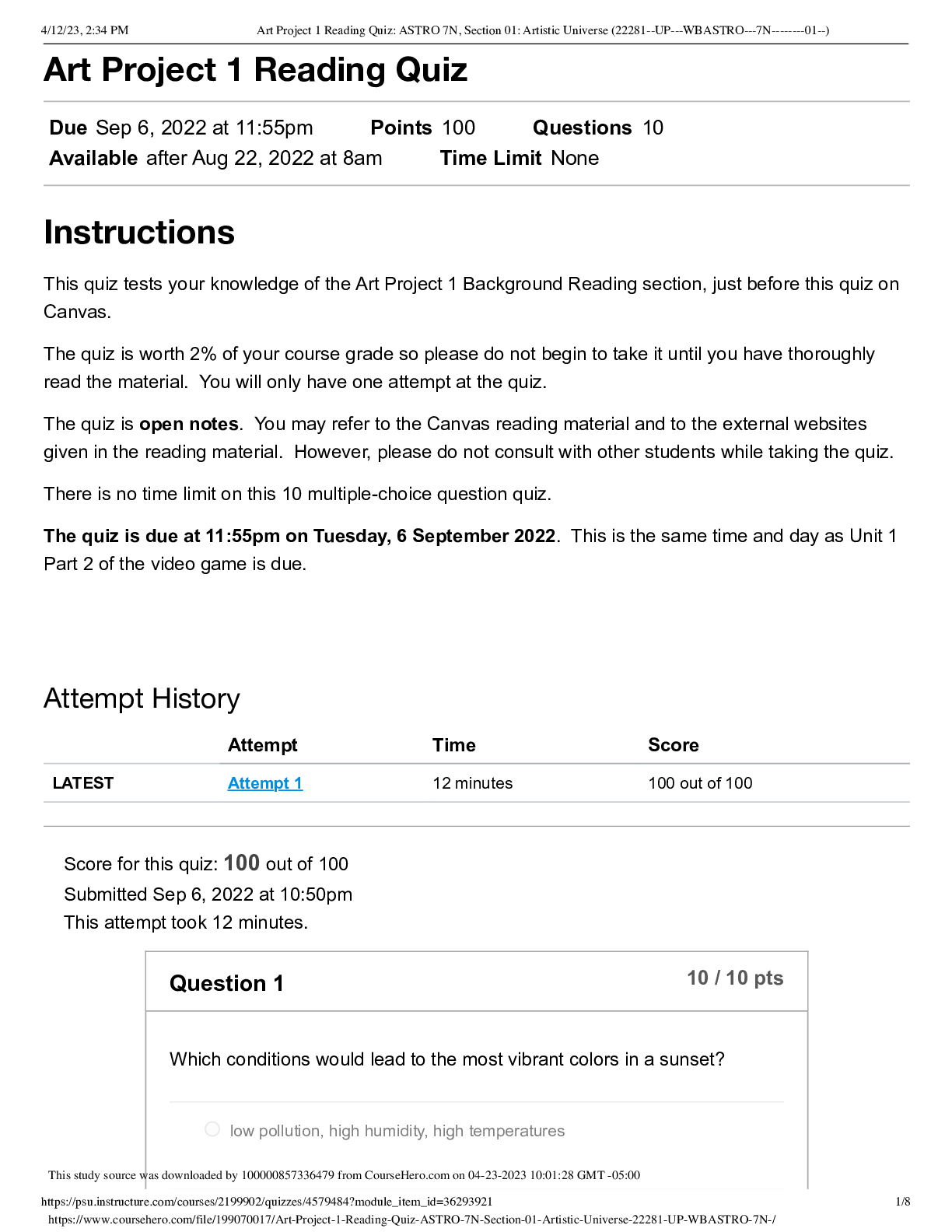Psychology > QUESTIONS & ANSWERS > Portage Learning PSYC 101. Score for this quiz: 96.5 out of 100. (All)
Portage Learning PSYC 101. Score for this quiz: 96.5 out of 100.
Document Content and Description Below
Question 1 Your Answer: What is the difference between descriptive and inferential statistics? Descriptive statistics summerizes data from a sample while inferential statistics allow researchers ... generalize to a broader population Question 2 4/7/22, 10:55 AM Final Exam - Requires Respondus LockDown Browser + Webcam: General Psychology-2021-11-Rice https://nursingabc.instructure.com/courses/1498/quizzes/37361?module_item_id=162194 2/23 Your Answer: In a research study, Doctor Akiva assigns some participants to drink 1 cup of coffee before doing a manual dexterity task and other participants to drink 3 cups of coffee before doing a manual dexterity task to test if caffeine affects performance. What is the independent variable? 3 cups of coffee Question 3 Your Answer: Five high-school English teachers were given a grammar test. Their scores were 17, 16, 14, 20, 20. What is the mean? Mean is sum of total score divided by number of scores Question 4 Your Answer: __________________ statistics summarize data from a sample, whereas ______________ statistics allow researchers to generalize to a broader population. Question 5 Your Answer: Five high-school English teachers were given a grammar test. Their scores were 17, 16, 14, 20, 20. What is the median? median is shows the average score at the middle when arranged 14, 16, 17, 20, 20 Median = 17 Question 6 Your Answer: Describe the three guidelines that govern the IRB to ensure ethical treatment of participants. 1. The participants must not be forced to carry out the research; they must be thoroughly informed about the nitty gritty of the resaerch to be carried out. 2. Participants must not be chosen with bias; this is so that the results will not be inaccurate and would be able to be generalized 3. The advantage of the research must outweigh the problems that comes, like in little Albert who his mother allowed to be used in the fear control experiment but was unable to overcome the fear in that case they were more at a disadvantaged place. Question 7 Your Answer: In a research experiment, what is the difference between a control group and a placebo control group? Why might researchers prefer to use a placebo control group? The control group is the group that is used to measure the out come the research that would be carried out they are not administered anything. The Placebo control group is the group that is administered something that has no medicinal effect. Researchers prefer to use the placebo control group to rule out the case of internal belifs of the participants because for instance if you were experimenting a drug and the independent groups were administered a drug and the control groups where administered nothing they would probably behave as though they would not get better because they were not given drug. Giving them a false belif rules out this factor. Question 8 Your Answer: Dr. Solman is a developmental psychologist who researches the physical changes adolescents experience as they enter puberty. If she is using the bio-psycho-social model, her research would be focused on the _________ aspect. Biological Question 9 Your Answer: Jamal was recently diagnosed with depression and is meeting with a therapist to address how he can change his thinking. According to the bio psycho-social model, this approach is most focused on the __________ factor. Psychological Question 10 Your Answer: A psychological researcher is interested in adolescent eating disorders and specifically investigates changes in levels of neurotransmitters that accompany eating disorders. Referring to the bio-psycho-social model, which part of the model is she most likely using? Biological Question 11 Which approach provides a holistic overview of human functions of mental processes and behaviors? The bio-psycho-social model Question 12 Your Answer: Max has been diagnosed with ADHD, and his doctor has prescribed him Adderall to help manage his symptoms. According to the biopsychosocial model, Max’s doctor is most focused on __________ factors. Biological Question 13 4 / 5 pts Your Answer: Using the biopsychosocial model, address the risk factors for development of anorexia nervosa. How might the risk factors be biological? Psychological? Social? anorexia nervosa is a disorder where there is a great caloric deficiency and staying away from food by the anorexic patient. They always want to be in control and do not believe they are extremely overweight even when told that they are. The risk factors are Biological because it affects the bodys major organs, and being extremely underweight is dangerous. Also, they are usually dehydrated and deficient of a lot of nutrients because they tend to stay away from food and use purging methods to get rid of food expecially when they binge eat. Psychologically, they do not believe they are extremely underweight and live in denial of their weight, they do not agree that they are thin and they have a terrible outlook on their outward appearance they always think they are fat. Finally, anorexia nervosa can develop when people around you like your family members, friends and collegues are so particular about how you look, the society at large has a societal acceptance of beauty that people try to conform to. Thus risk factors for development of anorexia nervosa can develop because of social reasons. biological factors Question 14 Your Answer: How can Maslow’s hierarchy of needs be understood using the bio psycho-social model? Maslow's hierarchy of needs cab be understood using the bio-psycho social model because it consists of 5 stages which are; Biological needs; which adresses the innate needs of the individual like food, water and sleepwhich are the most basic needs to survive and portrays the biological needs of the individual after which he is now able to think of Safety needs; the feeling of being secured and comfortable which a pschological aspect. Next, he needs to think of his Social needs; a feeling to belong, be loved and love which is a social need and adresses the social aspects of the individual. He can now move on to Esteem needs; having a good self esteem which basically comes from how you percieve yourself and this is a cognitive aspect of the bio psycho-social model. finally, Self actualization need; the need to reach your full potential which is both psychological and social because you want to be the best version of yourself and affect the society. Question 15 True or false: There is no such thing as a critical period for human brain development. False Question 16 Your Answer: What is the difference between obsessions and compulsions in someone with obsessive-compulsive disorder? Obesession are the unwated and persistent thoughts while the compulsions are the behaviors employed to take care of this thoughts which brings about a major distress in lifes functionaliity. Question 17 0 / 1 pts Your Answer: The central nervous system is made up of the ___________ and __________. Sympathetic Parasympathetic Question 18 0 / 1 pts Someone with post-traumatic stress disorder might find themselves jumping at every sound and more reckless than normal. What category of symptoms of PTSD do these fit into? Re-experiencing the trauma Hyperarousal Question 19 True or false: In classical conditioning, the natural biological relationship between a stimulus and response prior to conditioning is described as unconditioned. Question 20 Your Answer: Symptoms of schizophrenia can be described as positive, negative, or disorganized? What to these categories mean? What are examples of each of these types? Positive symptoms of schizophrenia are the symptoms that bring about an addition in the behavior like hallucinating, being disillutioned. That is when you start loosing touch with reality and beginning to hear voices in your head, and when you start having false believes that you have been abducted by aliens. Negative symptoms of schizophrenia ia when you become deficit of something like loosing expressions or becoming flat affective. That is when you do not show emotions or able to express feelings. Disorganized symptoms occurs when you are deranged, for example the possibility of barking like a dog Question 21 Your Answer: The diathesis-stress model suggests that there are two types of contributors that might lead to the development of schizophrenia. What are the two types, and how might they interact to lead to schizophrenia? According to the diathesis-stress model, Events that takes place could lead to the development of schizophrenia which could be trauma, stress or a major life change, also the biological changes that are present due to genetics or, chemical imbalances including irregularities in the structure of the brain which could also be psychological. Question 22 10 / 10 pts Your Answer: Describe the process of an action potential within a neuron, starting from when the cell is at rest and detailing the process through the neuron. When the cell is at it's resting potential, the neurons carry a slightly negative charge and sodium ion is outside the cell and pottasium ion is in the cell. When action potential is activated that is a stimulus like putting your hand on a hot top, the neurons become positive and the sodium membrane becomes permeable and then opens and sodium goes into the cell this is known as depolarization. When the sodium membrane closes after the electric charge reaches a certain level, the pottasium membrane opens and potasium ion goes out of the cell. This is known as repolarization. This action potential continues througout the lent of the axion until it reaches the end and realease chemicals known as the neurotransmitters at the synaps between the two neurons. Then calcium membrane is opened and goes into the cell and creates vessicles in which the neurotransimitters are attched to. The neurotransmitters are received by the receptors in form of a lock and key by the post synaptic neurons. The neurotransmitters that are small enough are absorbed by the pre-synaptic neuron which is known as reuptake and the larger neurotransmitters are broken down by some enzymes. This recycle is necessary so that the neurotransmitters will not keep activating action potential at the synaps. Question 23 Your Answer: Compare and contrast the function of rods and cones in vision. Cones help us see things in their colored form and enables sharp vision, while rods help us see in dim lights. Some nuctournal animals like the bats have more cones and so they are able to see clearly in the dark, while some other animals have more cones that help them see visions clearer and sharper. Humans have moderate amounts of cones and rods to help us see clolors and sharp visions and also help us see in dim light. Question 24 Your Answer: Compare and contrast conformity and groupthink. Be sure to both describe how they are similar (compare) and how they are different (contrast). Conformity is when you change your behavior to fit a group compared to what you intially believed. Conformity and groupthink are similar because you agree with other peoples opinion because you believe that they are right. They are different because a groupthink occures mostly in committee meetings where you have a dorminat leater and the groups are similar to one another. In conformity, you could comform due to the group size, or if there is a unanimousity in the task that you are given. Question 25 10 / 10 pts Your Answer: List and describe (including developmental time periods/age ranges) Erickson’s 8 stages of psychosocial development. Erickson's 8 stages of psychosocial development are; 1. Trust Vs. Mistrust 2. Autonomy Vs. Self Doubt 3. Initiative Vs. Guilt 4. Competence Vs. Inferiority 5. Identity Vs. Role Confusion 6. Intimacy Vs. Isolation 7. Generativity Vs. Stagnation, and 8. Ego Intergrity Vs. Despair Trust Vs. Mistrust: As children develop from toddler, they need to be able to develop trust with their parents or care givers. If their needs are properly and promptly met they are able to develop a sense of trust, but if they are neglected, and not responded to as expected they do not develop trust properly which could affect them even in adulthhod; they are not able to trust people. Autonomy Vs. Self doubt (Toddler); This is the stage when the toddler begins to understand that he is separate from his or her care giver or mother, when they are unable to attain autonomy, the begin to have selfdoubt Initiative Vs. Guilt (children); In this stage, children begin to take intitiative and understand that are are able to do things themself and are creative, failure to attain this leads to guilt. Competence Vs. Inferiority (pre-adolescent); the stage at which they believe that that are good at somethings and are beginning to find their identity; when they are unable to attain this they begin to feel inferior. Identity Vs. Role confusion; this occurs during adolescence when they are going through a period of major identity crisis trying to figure out who they are and what exactly they want to be doing with their lives. Most times when they seem not to be able to come to the terms of who they are it leads to role confusion, they are confused about what they should be doing. Intimacy Vs. Isolation (early adulthood); Intimacy occure in early adulthood when they begin to make decisions about the kinds of relationship they want either friendship or romance or they decide to stay alone by themselves and isolated. Generativity Vs. Stagnation (middle adulthood); In middle adulthood they begin to give back to the society and begin to mentor others to become better. This can be seen in parents with thier children. They get involved in the society or they are selfish about giving back, do not grow and become stagnated. Ego Intergrity Vs Despair (Late adulthood); In late adulthood, this individuals need to be satisfied with the live they have lived and appriciate all their achievements. The inability to do so will lead to regret and despair. Question 26 Maria is in the middle of planning her wedding, which is several months away. Although she’s excited, she still experiences stress about the whole event. What type of stressor is she most likely experiencing? Life change Question 27 4/7/22, 10:55 AM Final Exam - Requires Respondus LockDown Browser + Webcam: General Psychology-2021-11-Rice https://nursingabc.instructure.com/courses/1498/quizzes/37361?module_item_id=162194 18/23 Your Answer: What is insomnia? Insomnia is the inability to fall asleep and or stay asleep. Question 28 Question 29 Every time a child talks back to or “sasses” her mother, she loses access to her tablet for a day. This is an example of __________________. Question 30 Wilson is upset that he is running late for another meeting. What type of stressor is he most likely experiencing? Daily hassle Question 31 Your Answer: You are a nurse trying to get a cardiac patient to make some lifestyle changes. The patient believes that his behavior doesn’t matter because when his time is up, it’s up, and there’s nothing he can do about it. Does he have an internal or an external locus of control? What could you tell him to motivate him to make some lifestyle changes? He has an external locus of control. Empathetically, I would explain and try to convince him that he can take control of events that occur in his life and most times in life when we are motivated from the inside, we are able to take control of the events that happen in our lives. I can also explain to him that if he tries changing some of his lifestyles like eating right, taking walks and even having a positive attitude he can begin to feel better and come to realize that he can have control over his life and have a fighting spirit. Finally, I would tell him his loved ones would miss him and would want him to atleast try to have a positive look at life. Question 32 Your Answer: Identify and describe 4 ways to encourage healthy sleep. Four ways to encourage healthy sleep would be; 1. Having Regular sleep schedules; This would help your body develop a rhythm if you go to sleep at thesame time and wake at same time. Instead of irregular sleep times and trying to make up for sleep by sleeping in on weekends or holidays or staying up late during holidays. Having regular sleep schedules encourages healthy sleep. 2. Do not use yor bed for workspace; Using our bed for workspace can psychologically make the brain think we are working while on the bed instead of sleeping or getting ready to sleep. Creating a seperate workspace apart from where you sleep encourages healthy sleep. 3. Exercising before bed; Make sure to exercise at a longer period before going to bed. Do not exercise close to you sleeping time because this increases your heart rate and then when you are ready to go to sleep your heart rate needs to settle back in first before you then begin to fall asleep. 4. Finally do not get bright light into your eye just before bed time because this doesn't keep your circadian rythem on track. using your phones or laptops ar anything that makes light get into your eyes Question 33 Your Answer: John believes that any time he is feeling negative emotions, he needs to release all those negative feelings, but this behavior appears to be damaging his marriage. Based on what you learned about the myth of catharsis, what could you tell Mary to help her save her marriage? Include at least one reason catharsis is not the best response, and at least one alternate suggestion. People think that they should always vent out all of their emotions according to the myth of catharsis, but this in the real sense only causes more problems. Beacuse in the heat of anger, fights always happen. And so it is better and adviseable to try and calm down before making a major decision or speaking, you could do this also by writing notes to yourself which would not get a feed back so as not to aggraviate the anger again. Catharsis is not the best response because it causes more damage when you decide to vent all your negative emotions, it does not solve the problem instead it increases it. Question 34 Your Answer: Give an example of someone using top-down processing to perceive and explain how the example relates to the concept of top-down processing. Someone using a top-down processing to percieve situations is when they use their perception relating to what they have heard about it, or what they expect or presume to happen in a particular situation. They do not actually respond to the physical attributes of the stimulus, neither has it happened to them before. For example someone who hears a voice in the middle of the night and becomes frantic because they have watched a lot of horror movies or it is widely believed that evil happens in the night. [Show More]
Last updated: 1 year ago
Preview 1 out of 23 pages
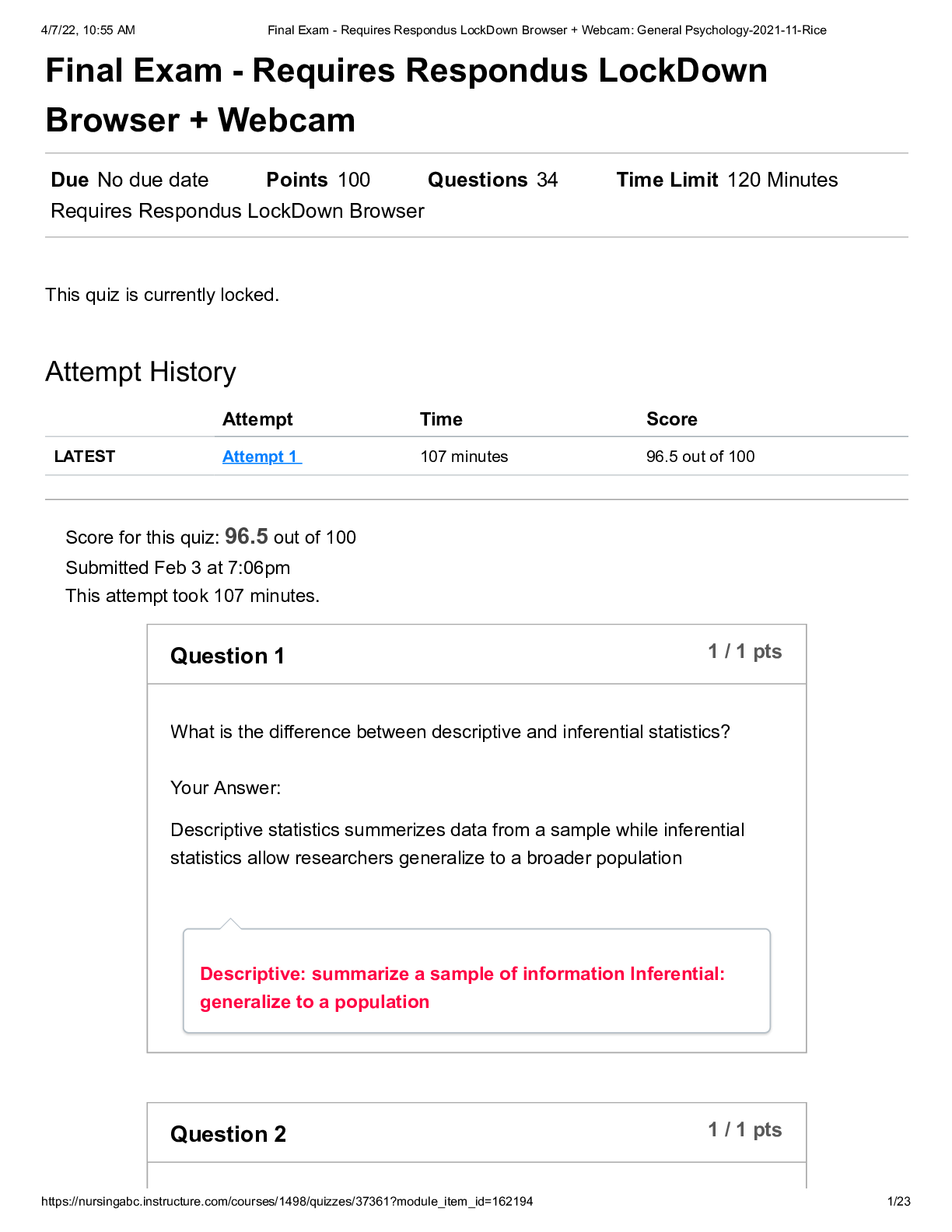
Reviews( 0 )
Document information
Connected school, study & course
About the document
Uploaded On
May 30, 2022
Number of pages
23
Written in
Additional information
This document has been written for:
Uploaded
May 30, 2022
Downloads
0
Views
90

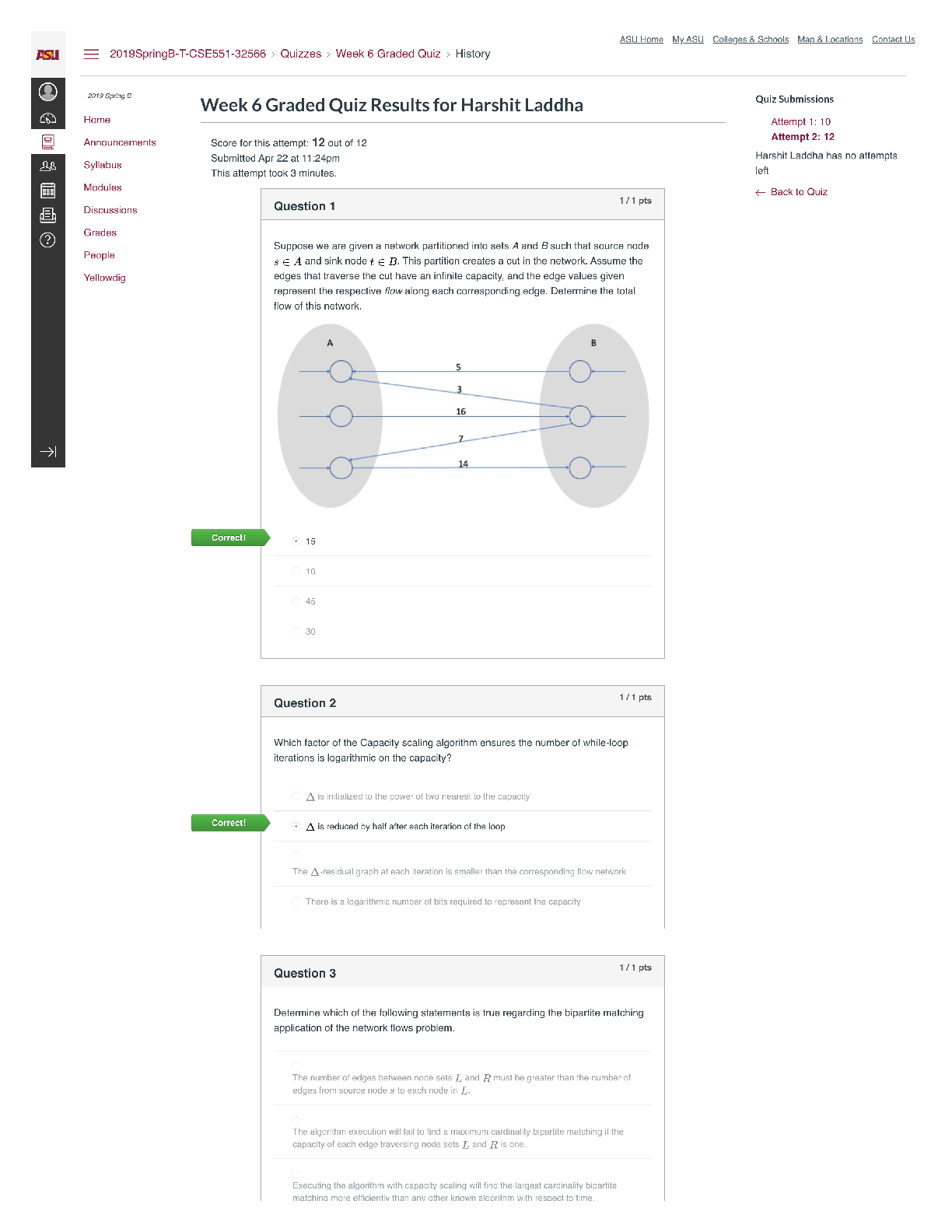

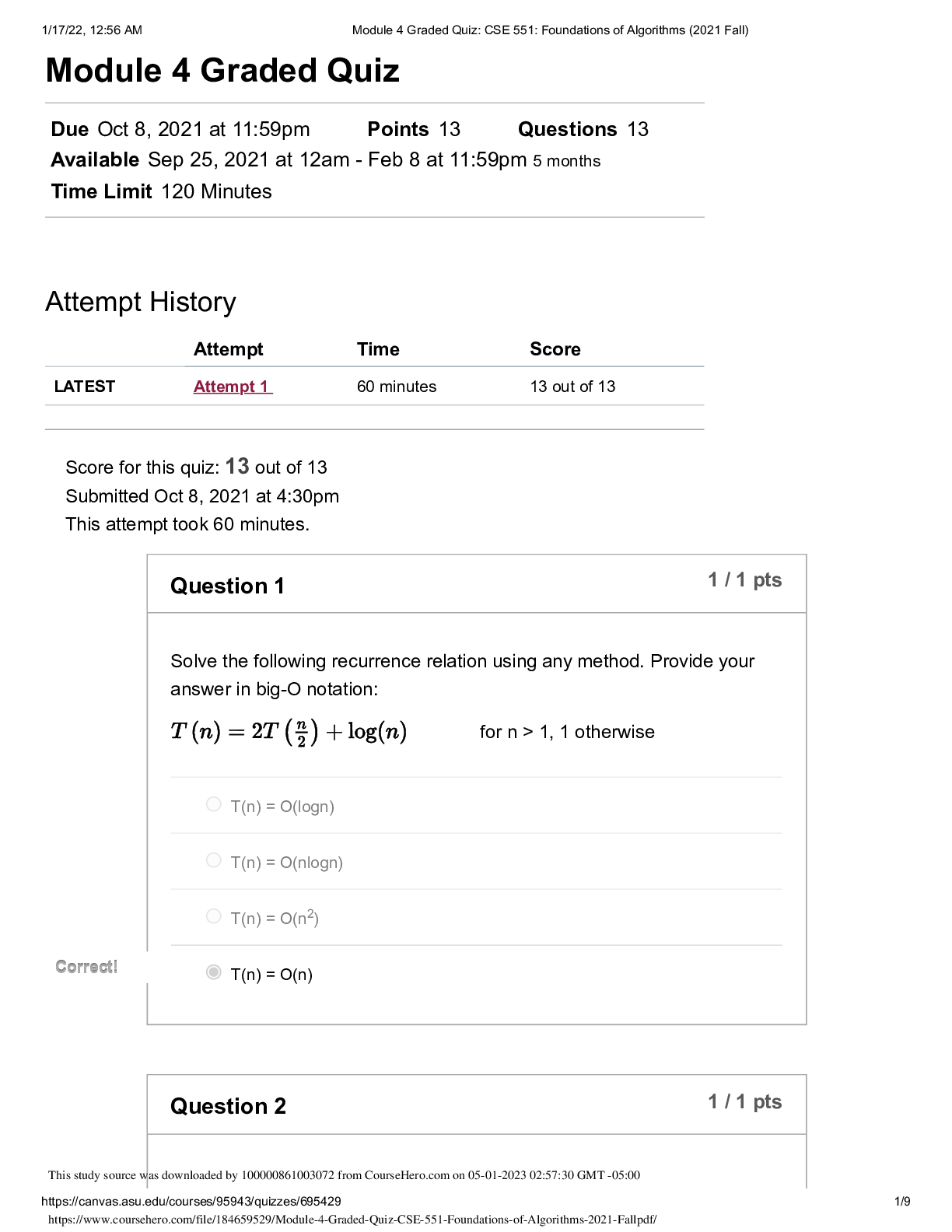
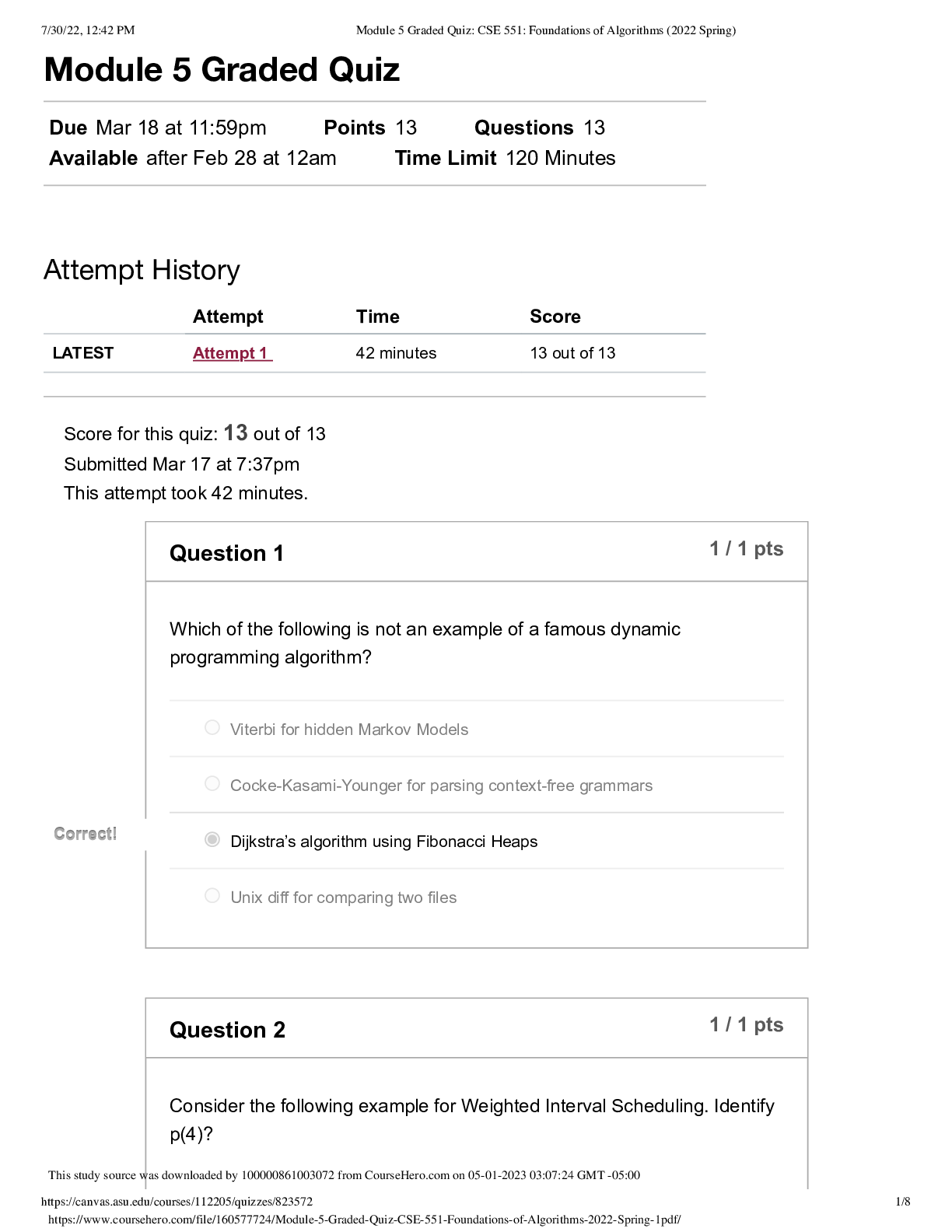
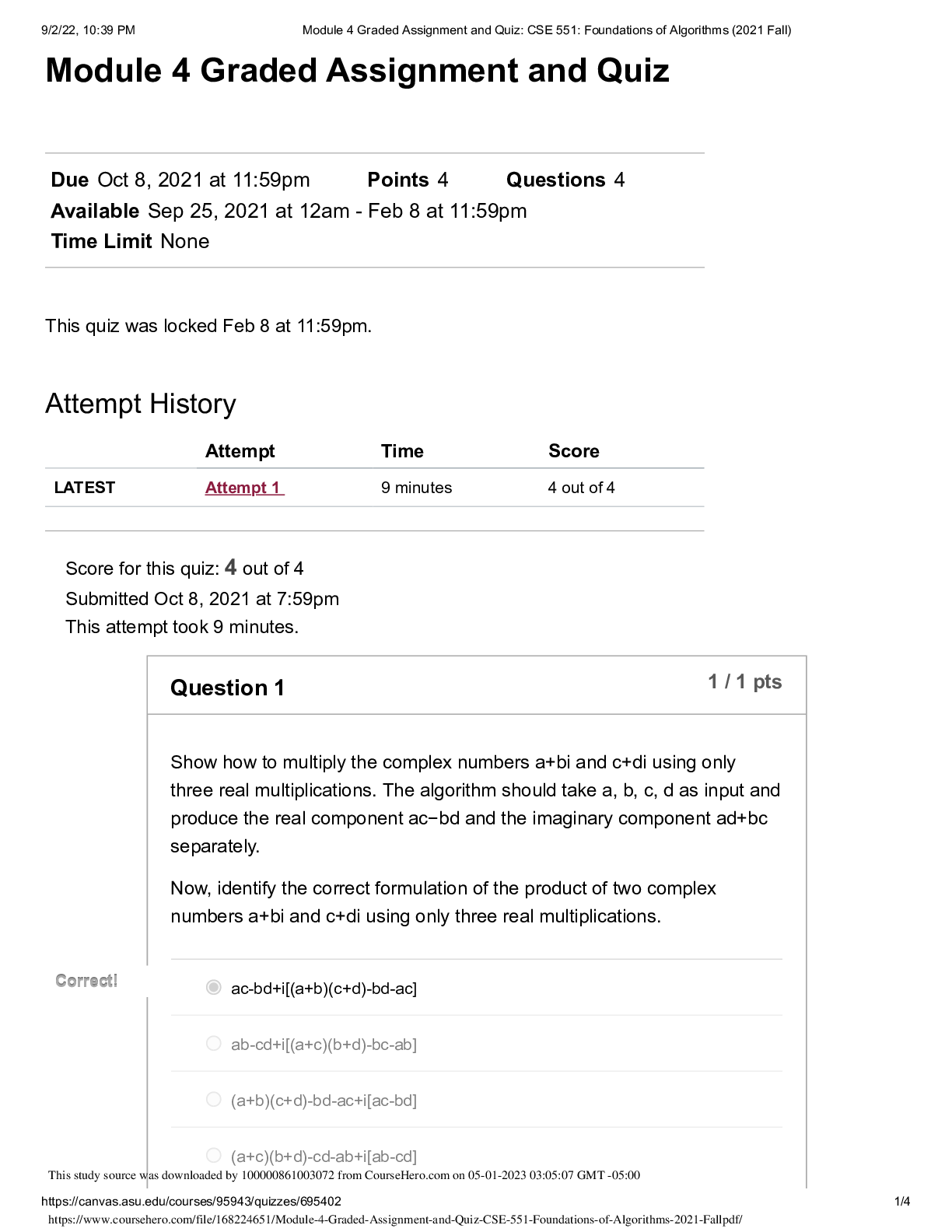
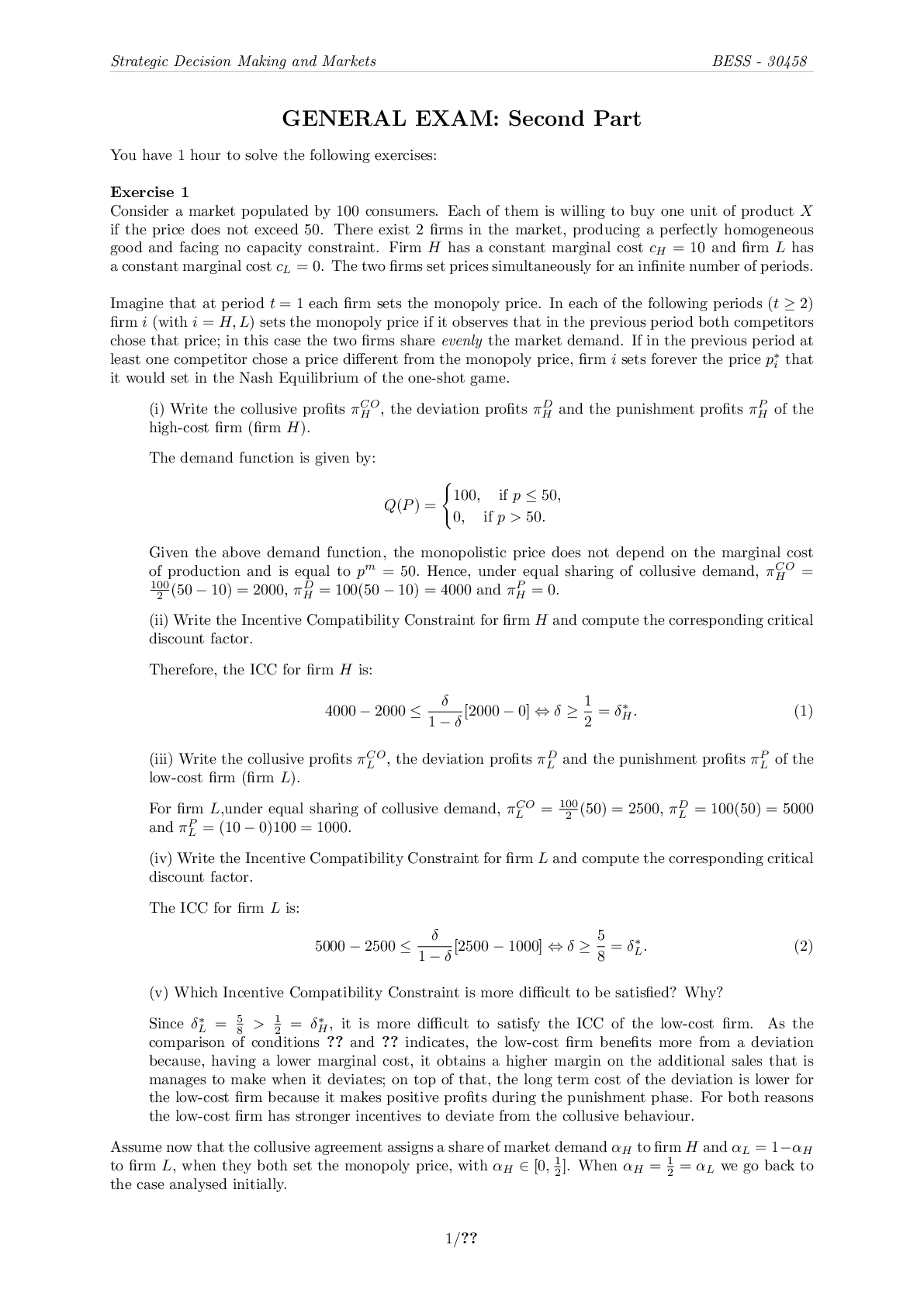

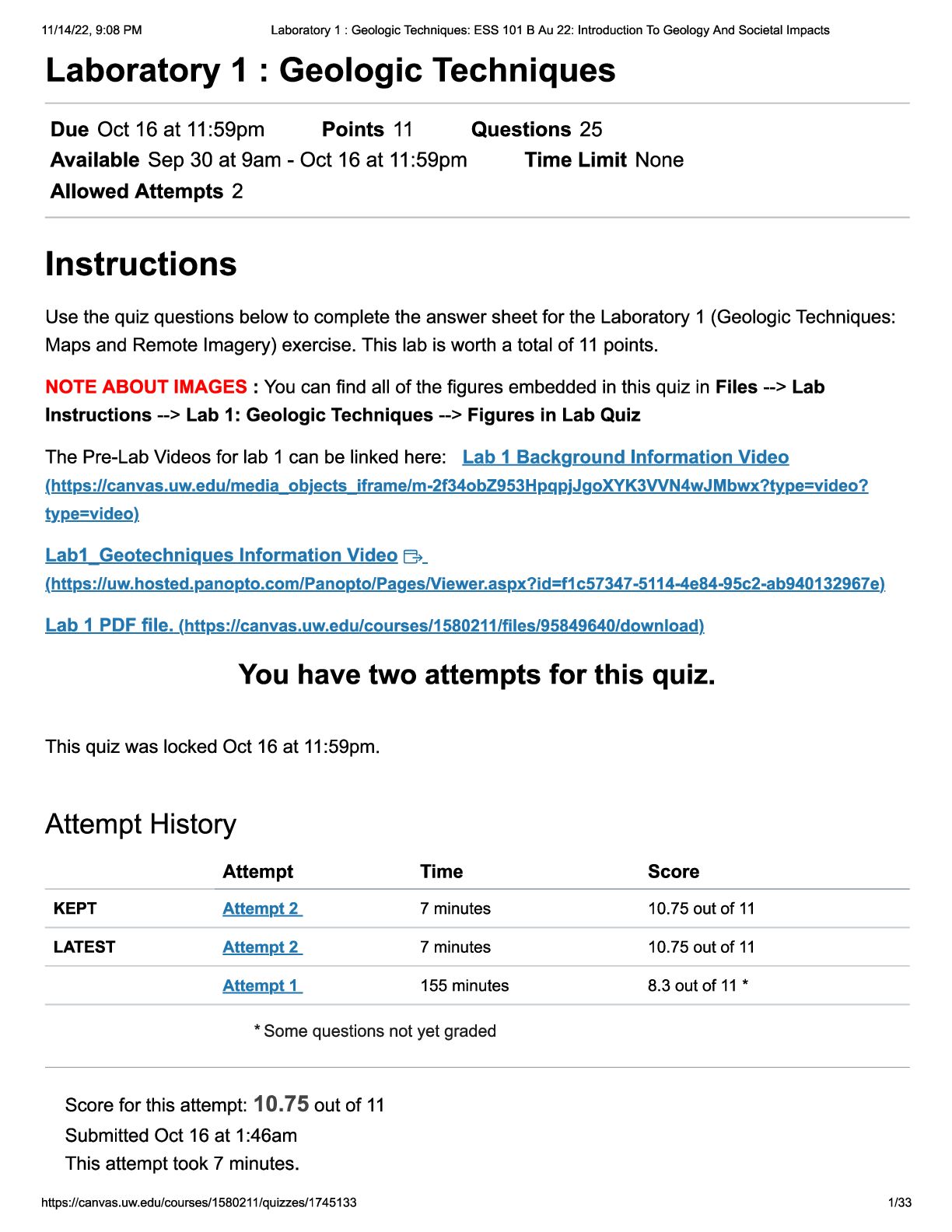






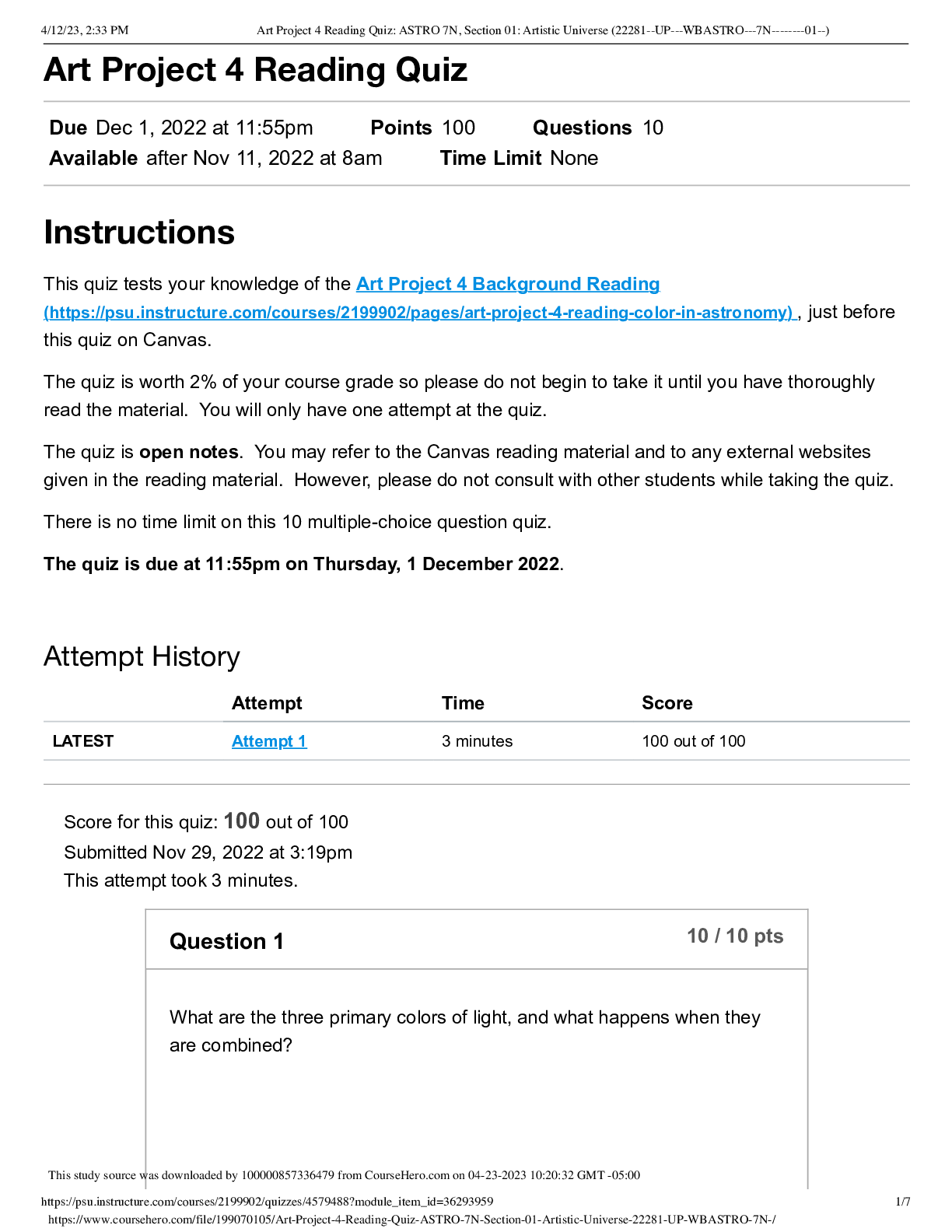
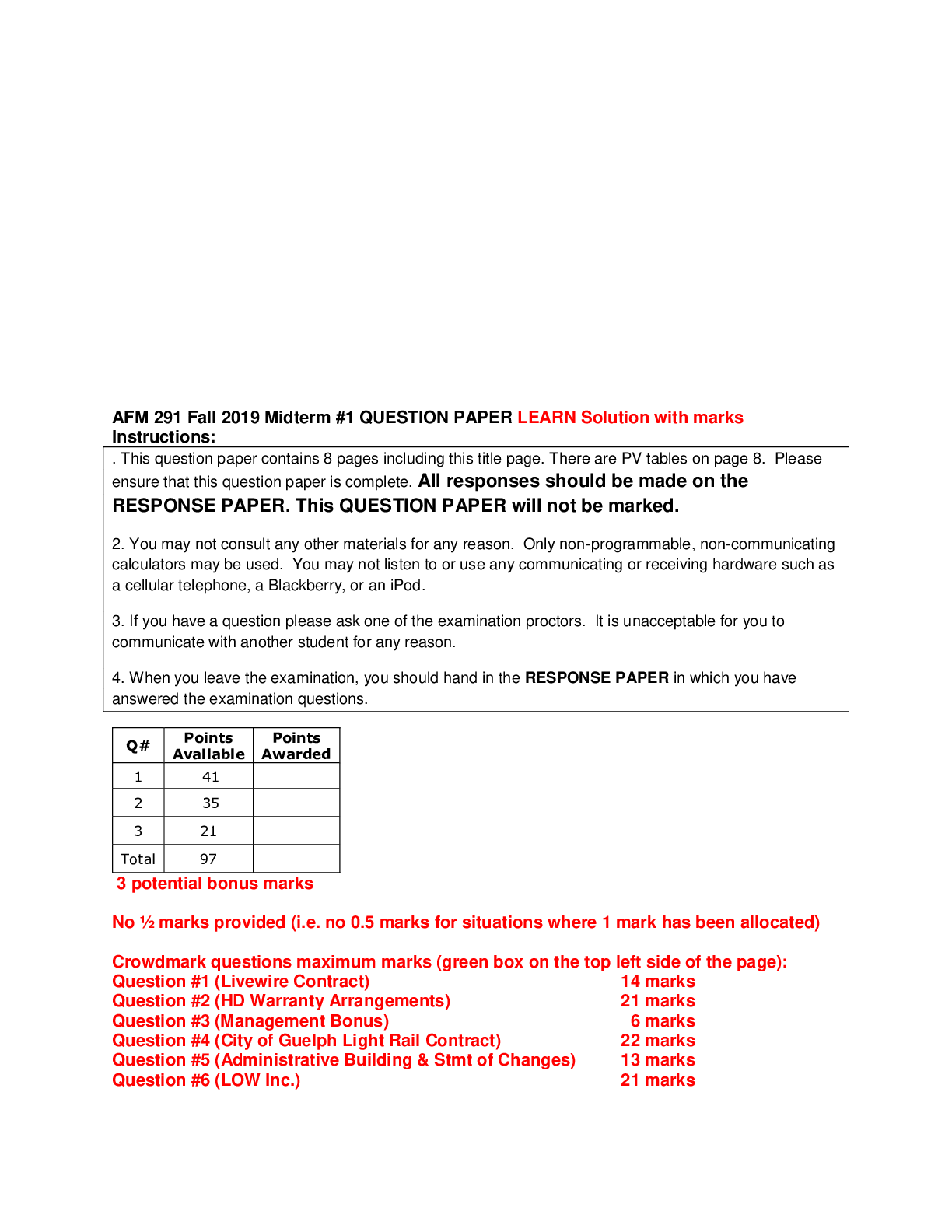



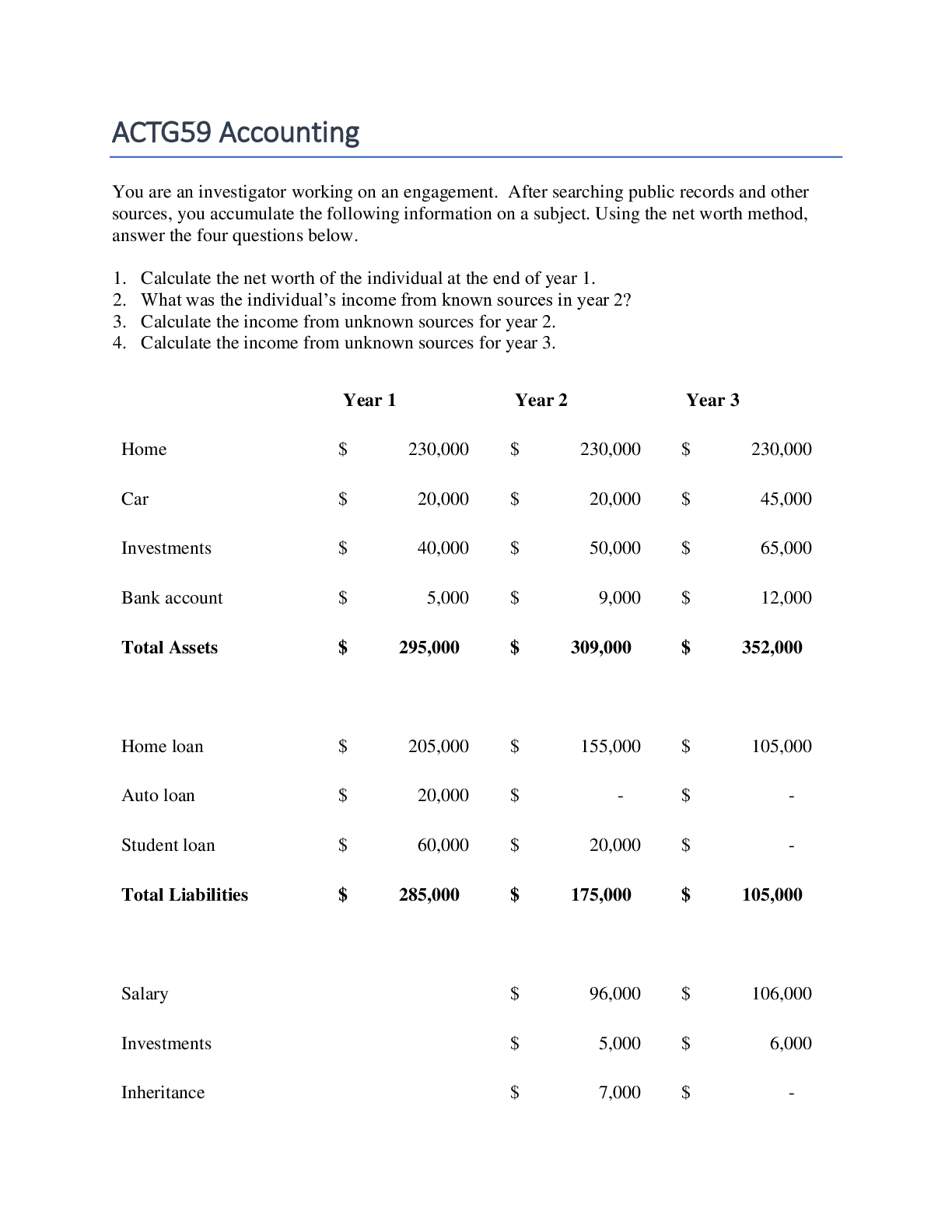



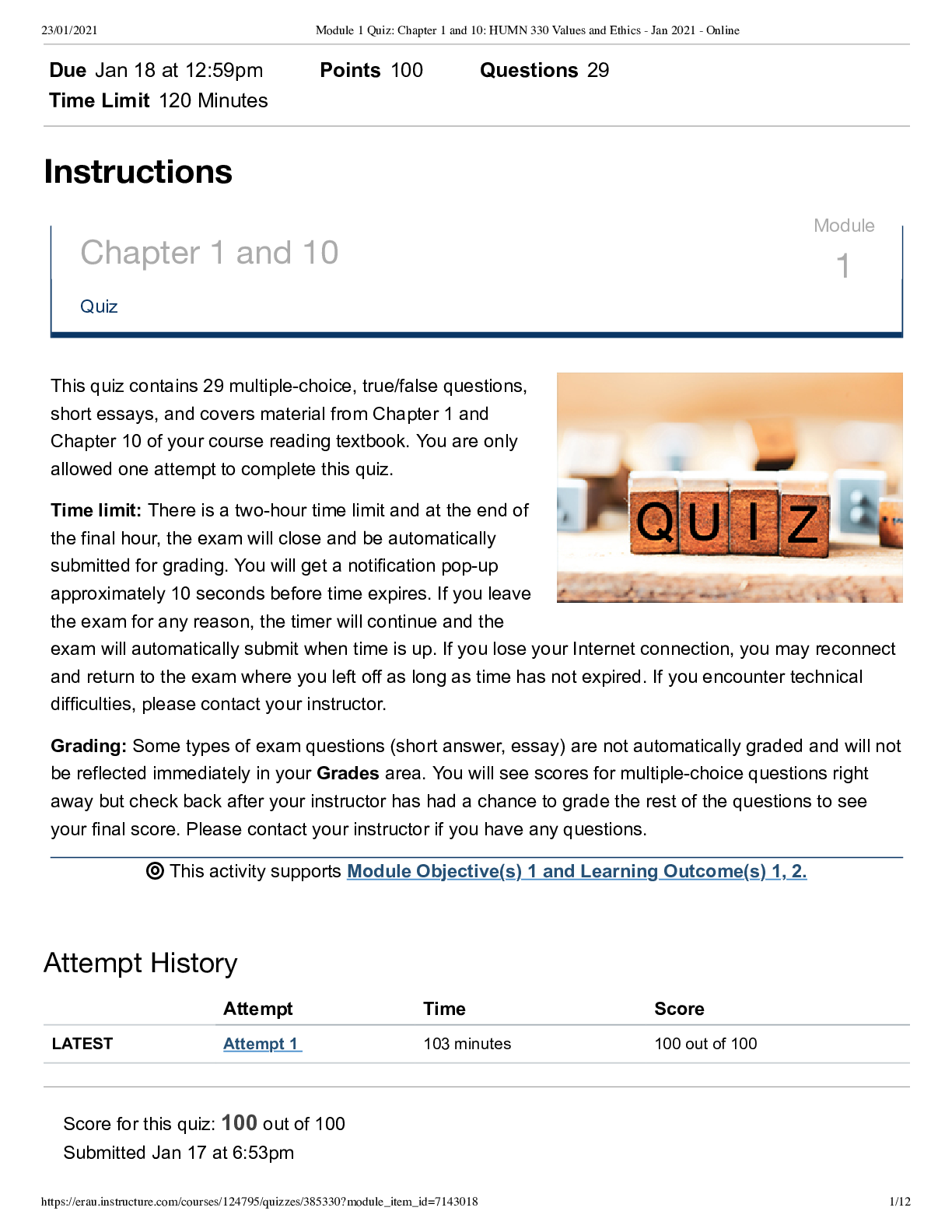



 nr507.png)
